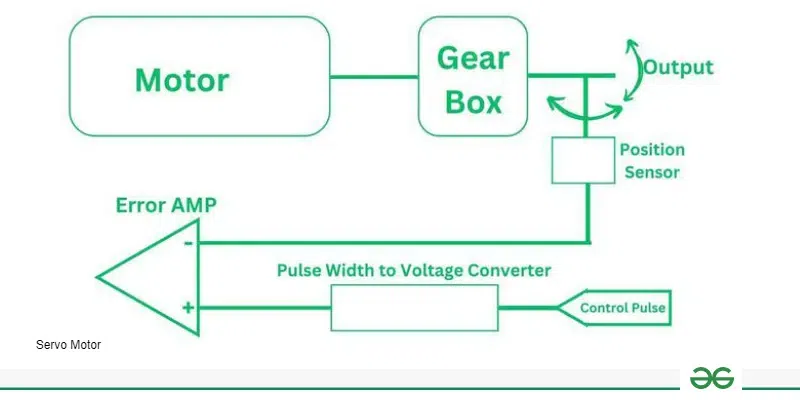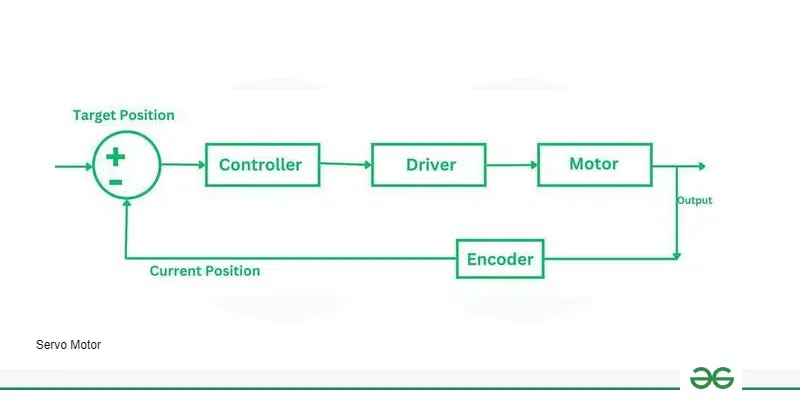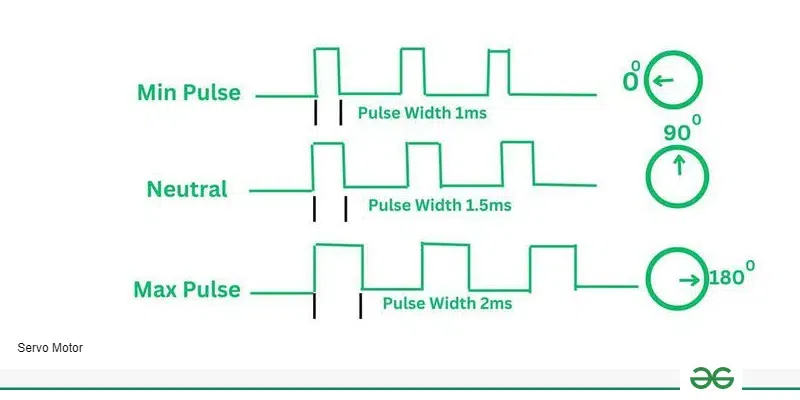A servo motor is a special kind of electric motor designed to enable precise and accurate movement. It is commonly used in applications such as robots or machines. A servo motor is like a smart motor because it can control its position, speed, and power. This motor works with a sensor that tells it where it is, and a controller makes sure it moves the way we want it to. People use these motors a lot in big machines, especially in places like factories where we need things to move very accurately and smoothly. This article discusses servo motors, and their importance in various fields such as robotics and manufacturing, explaining how they work, how they’re built, and where they are commonly used.
Servo motors are like powerful little engines with a high torque-to-inertia ratio, meaning they can generate a lot of twisting force relative to their size and weight. This makes them perfect for tasks that need quick acceleration, deceleration, and precise movements. They come in various sizes and power levels to suit different jobs and can be powered by either AC or DC voltage. What’s good is that we can control their speed and force using special signals called pulse width modulation (PWM). Some servo motors have extra features like built-in controllers and communication interfaces, which makes them adaptable and easy to integrate into complex systems.
What is a Servo Motor?
A servo motor is a rotary actuator that enables accurate control of angular position. It comprises a motor, a feedback system, and a controller. The feedback system constantly monitors the motor’s actual position and adjusts it to match the desired position. The controller interprets the difference between the actual and desired positions, sending signals to the motor to correct any variations.

Servo Motor
Construction of Servo Motor
The construction of a servo motor involves many key components that are used to enable precise control of angular position. A servo motor is similar to a regular motor, but it has more additional parts to facilitate position control. These essential components include sensors, gears, and a circuit. The motor is guided by a controller, such as Arduino or STM. In industrial applications, AC servo motors utilize an encoder as a position sensor, while DC servo motors employ a potentiometer for this purpose.
A DC servo motor is assembled by combining a DC motor with various components like a gearbox, controller, and potentiometer. On the other hand, an AC servo motor uses an induction motor, complemented by gears and encoders for precise control.

Construction of Servo Motor
Components of Servo Motor

Components of Servo Motor
- Rotor and Stator: The core of a servo motor consists of two main parts: the rotor (the moving part) and the stator (the stationary part). The rotor is typically connected to the output shaft, responsible for generating motion.
- Feedback Device: Incorporated within the servo motor is a feedback device, often in the form of an encoder or resolver. This device constantly monitors the actual position of the rotor and provides this information to the controller.
- Controller: The controller is the most important part of the servo motor system. It interprets the feedback from the encoder and compares it to the desired position. If there’s any difference, the controller calculates the necessary adjustment.
- Control Input: The servo motor receives control input, usually in the form of electrical pulses. The controller utilizes this input to determine how much and in which direction the motor should move.
- Power Supply: The motor requires a power supply, typically in the form of direct current (DC) or alternating current (AC), depending on the motor type.
- Gear Train (optional): In some servo motors, especially those used in robotics, a gear train may be included to amplify the torque or adjust the speed of the output shaft.
Working of Servo Motor
A servo motor works in a simple way and is easy to understand. Usually, a servo motor has a system called closed-loop control. This system includes a comparator and a feedback path. It’s like a setup that constantly checks and adjusts the motor to keep it in the right place. The comparator is an important part of the servo motor. It carefully checks where the motor is right now and compares it to where it’s supposed to be. If there’s a difference, it signals that there’s an error, telling the motor to make the necessary adjustments to get to the correct position.
The block diagram below shows the components of a standard servo motor control system:

Working of Servo Motor
Servo motors are commonly controlled using a method called Pulse Width Modulation (PWM). This technique requires the transmission of an electrical signal containing pulses of different lengths to the motor. These pulses have a width that varies between 1 to 2 milliseconds, and they are sent repeatedly at a rate of 50 times per second to the servo motor. The adjustment of the pulse width serves as a means to effectively control the position of the rotating shaft in the servo motor. In simpler terms, changing the duration of these pulses guides the motor in achieving the desired position for its rotating shaft.
Types of Servo Motor
Servo motors are broadly classified into two categories depending on their power source:
- DC Servo Motor
- AC Servo Motor
DC Servo Motor
A DC servo motor consists of essential components like a DC motor, position sensor, gear assembly, and control circuit. This motor allows precise control of speed and position. To set the desired output, a DC reference voltage is determined using a potentiometer, pulse converter, or timers. In digital control, microprocessors generate PWM pulses for accuracy. Feedback, obtained through a potentiometer, guides an error amplifier, ensuring precise motor positioning. The amplifier compares current and desired positions, generating an error voltage that powers the motor until the error is zero, facilitating accurate rotation.

Working of DC Servo Motor
AC Servo Motor
AC servo motors are a specific type of servomotor that converts AC electricity into precise mechanical movements, focusing on accurate angular velocity. Essentially, these motors are two-phase induction motors, featuring specific design distinctions. They produce mechanical power ranging from a few watts to several hundred watts, operating within a frequency range of 50 to 400 Hz. What sets them apart is their utilization of a closed-loop control system, employing encoders to monitor speed and position. This feature makes these motors exceptionally adept at precision and control, distinguishing them from others lacking such an advanced feedback system.

Working of AC Servo Motor
Characteristics of Servo Motor
Servo Motors features several key characteristics that make them an excellent choice for applications that require precise control and accuracy. Here are some key characteristics of servo motors:
- High Precision: Servo motors provide precise control over position, speed, and torque. This precision is achieved through the use of feedback devices such as encoders, which continuously monitor the motor’s actual position and provide feedback to the controller.
- Fast Response Time: Servo motors have an impressive response time, allowing them to quickly adjust their speed and position based on changing input signals.
- High Torque: Another characteristic of servo motors is their ability to deliver high torque even at low speeds. The high torque output of servo motors ensures that they can handle heavy loads and perform tasks with precision.
- Closed-Loop Control: Servo motors operate in a closed-loop control system, which means that they continuously receive feedback about their actual position and adjust their performance accordingly.
- Wide Speed Range: Servo motors offer a wide speed range, allowing them to operate at both high and low speeds without compromising performance.
- Low Inertia: Low rotor inertia enables quick acceleration and deceleration, contributing to the motor’s dynamic performance.
Difference Between Stepper Motor and Servo Motor
Both stepper motors and servo motors have their own advantages and are suitable for different applications. By understanding their differences, you can make an informed decision when selecting the motor that best fits your specific needs.
|
Characteristic
|
Servo Motor
|
Stepper Motor
|
|
Control Principle
|
Closed-loop system
|
Open-loop system
|
|
Accuracy
|
Higher accuracy due to feedback and closed-loop control
|
Lower accuracy compared to servo motors
|
|
Feedback Mechanism
|
Equipped with feedback devices (encoders, potentiometers) for continuous position monitoring
|
Typically lacks feedback
|
|
Cost
|
Tends to be more expensive
|
Generally more economical
|
|
Complexity
|
More complex control system due to closed-loop feedback
|
Simpler control system
|
|
Speed Variation
|
Capable of higher speeds and dynamic adjustments
|
Generally operates at lower speeds
|
|
Heat Generation
|
Can generate more heat, especially at higher speeds
|
Low heat generation
|
|
Torque at Low Speeds
|
Good torque at low speeds, but not as high as stepper motors
|
High torque at low speeds
|
|
Applications
|
Preferred for applications requiring high precision, dynamic response, and accurate position control, such as robotics and CNC machines
|
Often used in applications with less demanding precision and speed requirements
|
How To Control a Servo Motor?
Servo motors are operated by transmitting an electrical pulse, known as pulse width modulation (PWM), through a control wire. This pulse has a variable width and consists of a minimum and maximum value, along with a repetition rate. The servo motor typically has a limited range of movement, usually 180° in total, with a capability of turning 90° in either direction from its neutral position. The neutral position is the point where the servo can rotate equally in both clockwise and counter-clockwise directions.
The position of the servo motor’s shaft is determined by the duration of the PWM pulse sent through the control wire. The motor anticipates receiving a pulse every 20 milliseconds (ms), and the length of the pulse dictates how far the motor will turn. For instance, a 1.5ms pulse will position the motor at 90°. Pulses shorter than 1.5ms move the motor counter-clockwise toward the 0° position, while pulses longer than 1.5ms cause the servo to turn clockwise toward the 180° position.

Adjusting Servo Position by Varying the Pulse Width Control
Once directed to a specific position, these servos will maintain and resist any external force attempting to displace them. The extent of force a servo can withstand is referred to as its torque rating. It’s essential to note that servos don’t sustain their position indefinitely; a repetition of the position pulse is required to instruct the servo to stay in the designated position.
Interfacing Servo Motors with Microcontrollers
In order to control servo motors, they need to be interfaced with microcontrollers, which act as the brain of the system. There are several methods to interface servo motors with microcontrollers. One common approach is to use pulse width modulation (PWM). PWM works by varying the width of the pulse signal to control the position of the servo motor. The microcontroller generates the PWM signal, which is then sent to the servo motor. By changing the pulse width, the microcontroller can control the angle at which the servo motor rotates. To interface a servo motor with a microcontroller, you will need to connect the servo motor to the appropriate pins of the microcontroller.
Servo Motors have three wires:
The power and ground wires are connected to a power source, while the signal wire is connected to a PWM pin on the microcontroller. Once the hardware connections are made, you can start programming the microcontroller to control the servo motor. This involves writing code that generates the PWM signal with the desired pulse width. The microcontroller will continuously send the PWM signal to the servo motor, causing it to rotate to the desired angle. It is important to note that different servo motors may have different operating characteristics, such as the range of angles they can rotate or the speed at which they can move. Therefore, it is essential to consult the datasheet or specifications of the servo motor to ensure proper interfacing and control.
Applications of Servo Motors
Servo Motors have a wide range of applications across industries. Let’s explore some of the common applications of servo motors:
- Robotics: Servo motors are used in robot arms, grippers, and joints to achieve accurate positioning and smooth motion. This enables robots to perform tasks with precision, such as assembly, welding, and material handling.
- CNC Machines: Servo motors are extensively used in Computer Numerical Control (CNC) machines. They control the movement of the cutting tools, ensuring precise and consistent machining operations. The servo motors enable high-speed positioning and accurate control over the cutting process, resulting in superior quality and productivity.
- Industrial Automation: They are used in conveyors, packaging machines, printing presses, and other automated equipment. The precise control offered by servo motors ensures efficient and reliable operation, improving productivity and reducing downtime.
- Aerospace and Defense: Servo motors are used in aircraft control surfaces, missile guidance systems, and unmanned aerial vehicles (UAVs). The high accuracy and responsiveness of servo motors enable accurate control of flight surfaces and guidance mechanisms, ensuring safe and reliable operation.
- Electronics: Servos are commonly used in electronic devices such as cameras, where they facilitate autofocus and image stabilization. They are also found in consumer electronics like DVD players and home automation systems.
- Renewable Energy: Servo motors are used in solar tracking systems to adjust the position of solar panels, optimizing their orientation to the sun for increased energy capture.
Advantages and Disadvantages of Servo Motor
Here, we discuss the advantages and disadvantages of servo motors, helping you understand their capabilities and limitations:
Advantages of Servo Motor
A servo motor is a highly efficient and versatile motor that offers several advantages. Here are some of the key benefits:
- Precision Control: Servo motors provide precise control over position, speed, and torque, making them ideal for applications that require high accuracy and repeatability.
- High Torque: Servo motors can deliver high torque even at low speeds, making them suitable for tasks that require high force and power.
- Fast Response: Servo motors have a quick response time, allowing them to quickly adjust to changes in load or speed.
- Wide Speed Range: Servo motors can operate at a wide range of speeds, from very low to very high, making them versatile for various applications.
- Energy Efficiency: Servo motors are designed to be energy efficient, consuming less power when not in use and reducing overall energy costs.
Disadvantages of Servo Motor
While servo motors offer numerous advantages, there are also some disadvantages to consider:
- Complex Control: Servo motors require complex control systems and feedback mechanisms, such as Bode Plots in Control Systems, which can increase the overall complexity and cost of the system.
- Higher Cost: Compared to other types of motors, servo motors tend to be more expensive due to their advanced features and precision control.
- Size and Weight: Servo motors are generally larger and heavier than other types of motors, which may limit their use in certain applications with space constraints.
- Heat Generation: Servo motors can generate significant heat during operation, requiring additional cooling measures to prevent overheating.
- Noise: Depending on the design and quality of the servo motor, it may produce some noise during operation, which can be a concern in noise-sensitive environments.
Conclusion
In Conclusion, Servo motors are the precision powerhouses of electrical engineering, enabling precise control and accurate positioning in a wide range of applications. Their ability to deliver exceptional precision, high torque-to-inertia ratio, fast response time, and programmability makes them indispensable in industries such as robotics, aerospace, and manufacturing. As technology continues to advance, servo motors will undoubtedly play an even more significant role in shaping the future of electrical engineering.
FAQs on Servo Motor
What is servo motor in electrical engineering?
A servo motor in electrical engineering is a specialized type of electric motor designed for precise control of angular or linear position, speed, and torque. It consists of a motor, a feedback sensor, and a controller, ensuring accurate and controlled motion in various applications.
Is a Servo Motor asynchronous?
No, a servo motor is not asynchronous; it is typically synchronous. Its rotor rotates at the same speed as the stator’s magnetic field, allowing precise control of position and motion.
What is the structure of a servo motor?
A servo motor’s structure includes a motor for rotational motion, a feedback device (encoder or resolver) for position monitoring, and a controller that interprets signals, ensuring precise and controlled movement.
Can servo motors spin?
Yes, servo motors can spin. They are designed to provide rotational motion and can spin continuously or move to specific positions with high precision, making them versatile in various applications.
How does a servo motor rotate?
A servo motor rotates in response to electrical signals from a controller, interpreting and directing the motor’s components, like the rotor and stator, for accurate and controlled rotational movement.
Share your thoughts in the comments
Please Login to comment...